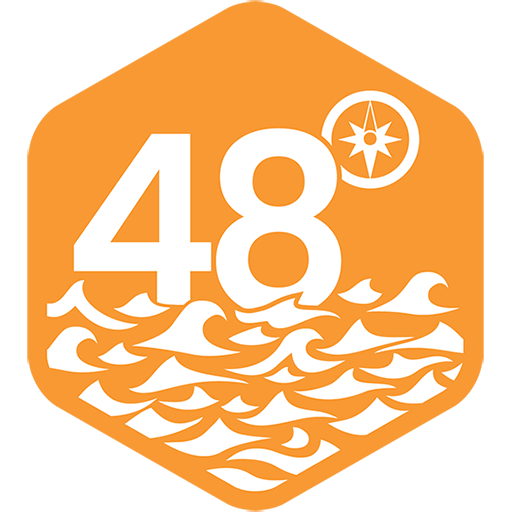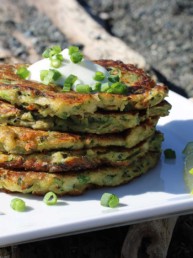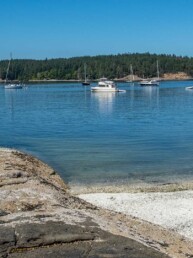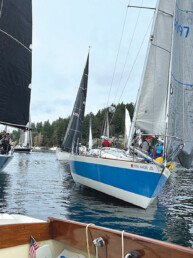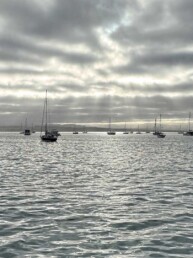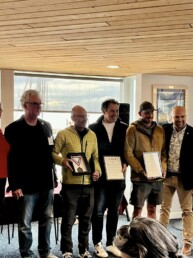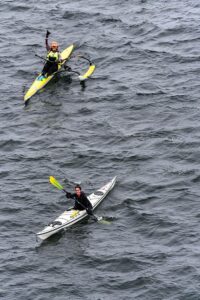
Between my upbringing and the path that has led me to advocating for waterpeople, I am adaptable and accustomed to pivoting. So, when Sarah Craig from the environmental organization Trash Tramp Inc. and I put our heads together to create a two-day Adventure Paddle Clinic that focused on prep for the Seventy48 race — which we’ve both completed — we kept in mind the old adage, ”The best laid plans of mice and men often go awry.”
We knew Mother Nature was a collaborator but we also knew her role in our clinic would be a mystery until approximately 72 hours before the event. We kept our fingers crossed that we would not be faced with the difficult scenario of a small craft advisory during the weekend of April 15-16.
The plan was to have all guests arrive at the Southworth Ferry Dock just south of Blake Island and paddle approximately 12 miles to Lemolo near Poulsbo. Once there, we would store our boats on a secluded beach at a friend’s private residence and begin the suggested schedule of race tactics, safety, fuel, apparel, and chart work. Afterwards, we’d do a beach clean-up and Sarah would offer an environmental talk. We envisioned ourselves sharing a meal by the fire on the beach and then meandering out to the MV Badger, a friend’s 70-foot converted Canadian Navy vessel, to slip into our bunks and be rocked gently to sleep in the bay. The next day, we would complete our circumnavigation of Bainbridge Island going clockwise through Agate passage and end the retreat with a nice 20 mile stretch back to the ferry dock. Mother Nature said… nope.
As the weekend approached, the forecast called for southerly gusts to 30 knots. Super fun for a downwind session, but not as good for a circumnavigation. After deliberation, we concluded that having all guests meet in Lemolo at the residence first thing Saturday morning was the best option. We adjusted the retreat plan to entail two northbound legs. The guest list included two stand-up paddlers, two OC-1 (outrigger canoe) paddlers, and a kayaker; all of whom are entered in this year’s Seventy48, as well as an additional OC-1 paddler who is contemplating racing in 2024.
We met on a misty morning and made our introductions. After assembling our gear, we started our shuttle — Mother Nature is on a schedule. With mixed boats comes a mixed bag of transportation issues. We “strategized” and ferried humans and cars to our destination at the Kingston Ferry Terminal,
a 12 mile paddle through Agate Pass. I wasn’t going to give that one up. I have been wanting to paddle through there for a while.
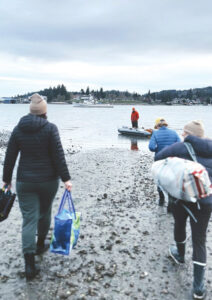
Paddles were in the water by midday and we had the breeze and the current on our side, or backs rather. Douglas Ludwig, photographer and owner of Badger, met us as we passed under the bridge at Agate. The bright colors of the various human-powered vessels popped against the steely water and sky. We hung a left coming out of Port Madison Bay and enjoyed a gentle downwind ride all the way to the haul out. When paddling downwind, there can be periods where the waves and wind moderate to a mellow, predictable pattern. I call it prairie grass, it’s like gliding on hypnotic velvet, and we had some lovely prairie grass during this stretch.
Many Pacific Northwest boaters know it well, but the boat launch at Kingston Marina is a perfect spot. Public restrooms and ample parking easily accommodates large groups. After our uneventful and scenic paddle, we looked forward to some soup and a warm fire (pivoting indoors from the beach fire plan due to rain). Our gracious hosts in Lemolo welcomed us, and we sat in an intimate group in the living room overlooking the bay, fire crackling, filling our bellies, and sharing stories. This is the best part for me — the ignition of friendships as connections deepen and contact info is exchanged to accommodate exciting new plans inspired by a wonderful day together.
As Sarah and I began our planned discussions about community and environment, the engagement grew. It does not surprise me anymore what kinds of conversations come out of these events. We reflected on equality in the maritime industry, in sports, and in our own families; and the ways our on-the-water aspirations intertwine with what we put in our bodies and our hearts. These are not only athletes and adventurous humans , but holistic waterpeople who see the interconnectedness of the things we love and the ongoing need for advocacy.
As the sun set, we put on our galoshes and portaged our belongings from the watery depths of our conversation out to our comfortable accommodations aboard Badger. Once on board, we looked over charts and collectively came up with a plan for the next day. The winds were to intensify on Sunday. Again, it was looking like a downwinder and, since we had guests from Vancouver, British Columbia and Hood River, Oregon, we could not wait for optimum wind. We had to put in early at Kingston to hit tides that would allow us around Point No Point to reach Hansville before the switch.
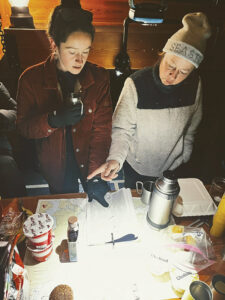
Sarah and I woke up at 4 a.m. to start the coffee, Douglas prepared a scramble, and we started the dinghy train out to the beach. With all of these moving parts, I was impressed at how everyone worked to keep on schedule. I wanted blades in the water at 8 a.m. in Kingston. No sweat. Again, we did the shuttle game, this time to the haul out at Hansville.
Then, into the water we went. As we came out of the marina, we saw that the ferry was gearing up to depart. The schedule said it should be off by then, but it was a bit behind. We decided to not take our chances but to wait until it was safely on its way.
I was excited to take the group on this section of the race course. For me, it feels like the “big turn” towards the homestretch. Paddling towards Point No Point is paddling towards the possibility of actually completing a 70-mile race, one that seems so daunting in those first few miles out of Tacoma. Of course, a bonus is that it is also a beautiful patch of water. I always manage to have a moment with a sea eagle around there, and have decided they must be gatekeepers of sorts. From the perspective of a stand up paddler, the seafloor mesmerizes you as you fly along, too — starfish, crab, and the like.
Thankfully, the worst weather waited for us. Every once in a while, I would look over my shoulder and see the dark water line getting closer and the black clouds tripping over themselves as they headed our way. We kept just ahead of it the whole time.
As expected, everyone was struck by the beauty of Point No Point and Hansville. White sandy beaches, sea otters, seals, and the confluence of various current patterns signal the literal and figurative turning point. As we hauled our boats out, the wind hit us. We quickly got out of our wet clothes, and bundled up to load our gear. With another great 12-mile paddle under our belts, we debriefed over burgers at Hansgrill Hansville Grocery and Provisions Co.
Sometimes, the memorable adventures are the ones where the sun shone on your face, wind and water synchronized to align with your agenda, and beach bonfires blazed with stories. Other times, like this amazing weekend in April, adventures bring a group together to analyze real time scenarios, be flexible, and collaborate with each other and the conditions. We had to keep one another safe and offer warmth, support, and sustenance. We will remember the cold fingertips and the frosty breath, sure, but the appreciation of the accomplishment, bravery, and the warm cup in your hands afterwards is the real story. I cherish these waters, the activity of paddling, and this community more than I can put into words.
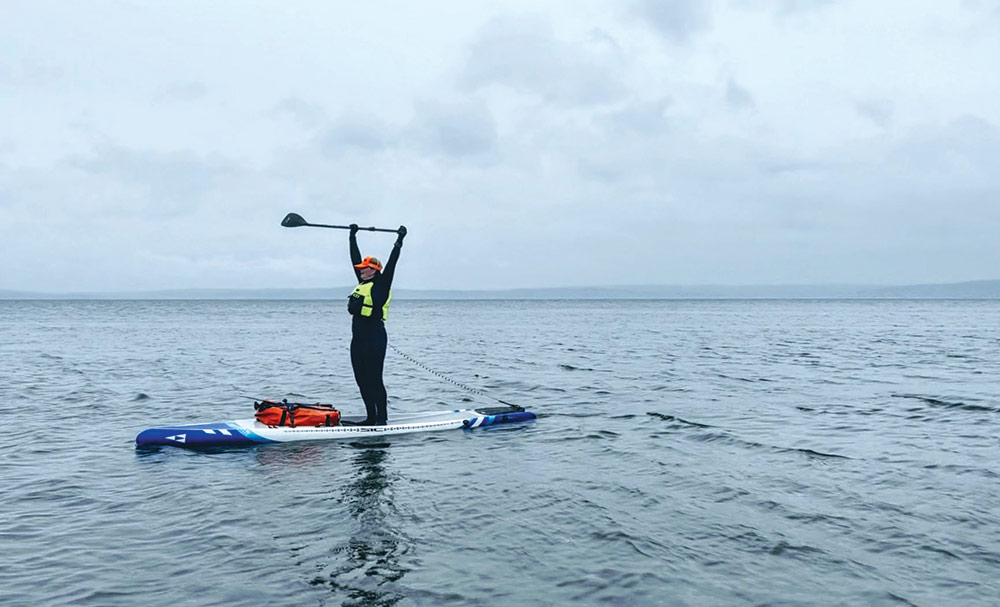
Erica Lichty is the founder of the SEASTR, a non-profit that promotes women who adventure in the Pacific Northwest. She is also the Education Coordinator for Seattle’s Maritime High School. Check out: www.seastrpnw.com
All photos by Douglas Fir Photography.
Erica Lichty
Erica Lichty is the founder of the non-profit, SEASTR, which was founded to optimize the human/environment connection, using water to engage women in their own process of healing and evolution, making a difference for themselves, their families, and their communities.
